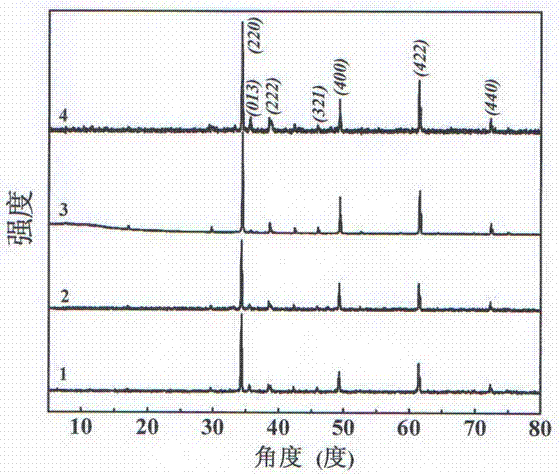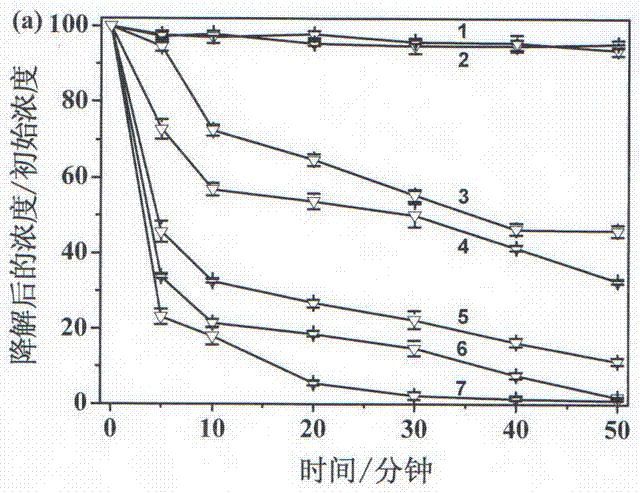Method for degrading antibiotics by using double perovskite photocatalyst calcium copper titanate
A photocatalyst, copper calcium titanate technology, applied in chemical instruments and methods, special compound water treatment, light water/sewage treatment, etc., can solve the problem of antibiotic degradation of new copper calcium titanate catalyst, which has not been reported yet, and has not yet involved antibiotics Pollutant degradation application and other issues
- Summary
- Abstract
- Description
- Claims
- Application Information
AI Technical Summary
Problems solved by technology
Method used
Image
Examples
Embodiment 1
[0020] a. The antibiotic is tetracycline dissolved in water, and the concentration is 1×10 -5 mol / L solution, and then placed in ultrasonic treatment to make it a uniform and stable solution;
[0021] b. Under light-shielding conditions, add 40 mg of cubic photocatalyst calcium copper titanate to the solution obtained in step a, stir for 30 minutes, wrap in tin foil, and store in the dark;
[0022] c. The solution system in step b is irradiated with visible light by a 300W xenon lamp with a wavelength of 420nm, and the light energy density is 700mw / cm 2 , the temperature is kept at room temperature 25°C, the remaining solution system is 10cm away from the outlet of the xenon lamp, and 4mL is sampled every 10min;
[0023] d. After centrifuging the sample taken out, take the supernatant to test high-performance liquid chromatography and high-resolution mass spectrometry, analyze the degradation efficiency and degradation products of pollutants, and test the degradation rate of ...
Embodiment 2
[0025] a. The antibiotic is tetracycline dissolved in water, and the concentration is 1×10 -5 mol / L solution, and then placed in ultrasonic treatment to make it a uniform and stable solution;
[0026] b. Under light-shielding conditions, add 40 mg of polyhedral photocatalyst calcium copper titanate to the solution obtained in step a, stir for 30 minutes, wrap in tin foil, and store in the dark;
[0027] c. The solution system in step b is irradiated with visible light by a 300W xenon lamp with a wavelength of 420nm, and the light energy density is 700mw / cm 2 , the temperature is kept at room temperature 25°C, the remaining solution system is 10cm away from the outlet of the xenon lamp, and 4mL is sampled every 10min;
[0028] d. After centrifuging the sample taken out, take the supernatant to test high-performance liquid chromatography and high-resolution mass spectrometry, analyze the degradation efficiency and degradation products of pollutants, and test the degradation rat...
Embodiment 3
[0030] a. The antibiotic is tetracycline dissolved in water, and the concentration is 1×10 -5 mol / L solution, and then placed in ultrasonic treatment to make it a uniform and stable solution;
[0031] b. Under light-shielding conditions, add 40 mg of nanorod-shaped photocatalyst copper calcium titanate to the solution obtained in step a, stir for 30 minutes, wrap in tin foil, and store in the dark;
[0032] c. The solution system in step b is irradiated with visible light by a 300W xenon lamp with a wavelength of 420nm, and the light energy density is 700mw / cm 2 , the temperature is kept at room temperature 25°C, the remaining solution system is 10cm away from the outlet of the xenon lamp, and 4mL is sampled every 10min;
[0033] d. After centrifuging the sample taken out, take the supernatant to test high-performance liquid chromatography and high-resolution mass spectrometry, analyze the degradation efficiency and degradation products of pollutants, and test the degradation...
PUM
 Login to View More
Login to View More Abstract
Description
Claims
Application Information
 Login to View More
Login to View More - R&D
- Intellectual Property
- Life Sciences
- Materials
- Tech Scout
- Unparalleled Data Quality
- Higher Quality Content
- 60% Fewer Hallucinations
Browse by: Latest US Patents, China's latest patents, Technical Efficacy Thesaurus, Application Domain, Technology Topic, Popular Technical Reports.
© 2025 PatSnap. All rights reserved.Legal|Privacy policy|Modern Slavery Act Transparency Statement|Sitemap|About US| Contact US: help@patsnap.com



